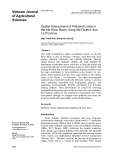
Methods of wastewater treatment
-
This study evaluated the impact of pollution sources on the Ma River Basin in Son La Province, Vietnam, using data from local reports, statistical yearbooks, and scholarly literature. The study recommended implementing centralized wastewater treatment systems in priority areas, promoting sustainable land management practices, and supporting environmentally friendly agricultural and livestock farming methods.
 14p
14p  tuetuebinhan000
tuetuebinhan000
 23-01-2025
23-01-2025
 3
3
 2
2
 Download
Download
-
Objectives of the thesis: The objective of this study is to develop an energy and nutrients recovering wastewater treatment process combining physicochemical and biological methods for NRP wastewater.
 26p
26p  extraenglish
extraenglish
 24-05-2021
24-05-2021
 32
32
 3
3
 Download
Download
-
The objective of this study is to develop an energy and nutrients recovering wastewater treatment process combining physicochemical and biological methods for NRP wastewater.
 26p
26p  kequaidan7
kequaidan7
 01-09-2020
01-09-2020
 19
19
 4
4
 Download
Download
-
This article discusses testing results of industrial trial of new wastewater disinfection comprised of combined use of ultrasonic and ultraviolet methods at final stage of wastewater treatment aimed at elimination of pathogenic organisms, thereby preventing spread of infectious diseases.
 8p
8p  lucastanguyen
lucastanguyen
 01-06-2020
01-06-2020
 18
18
 2
2
 Download
Download
-
Research Reports IWMI’s mission is to improve the management of land and water resources for food, livelihoods and environment. In serving this mission, IWMI concentrates on the integration of policies, technologies and management systems to achieve workable solutions to real problems—practical, relevant results in the field of irrigation and water and land resources.
 39p
39p  nhatro75
nhatro75
 12-07-2012
12-07-2012
 72
72
 8
8
 Download
Download
CHỦ ĐỀ BẠN MUỐN TÌM


















